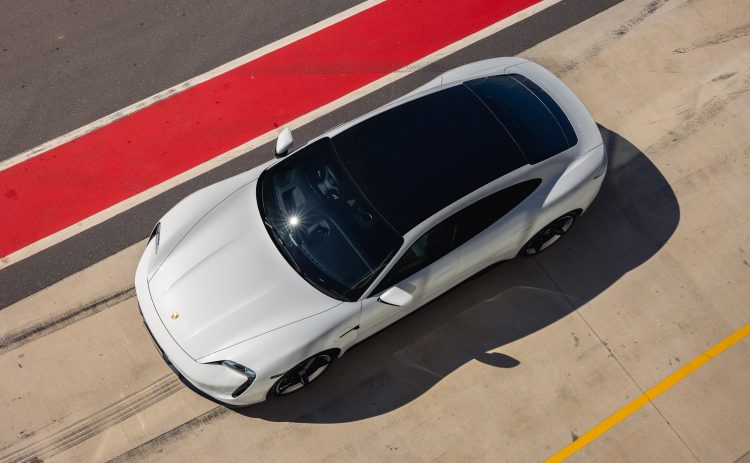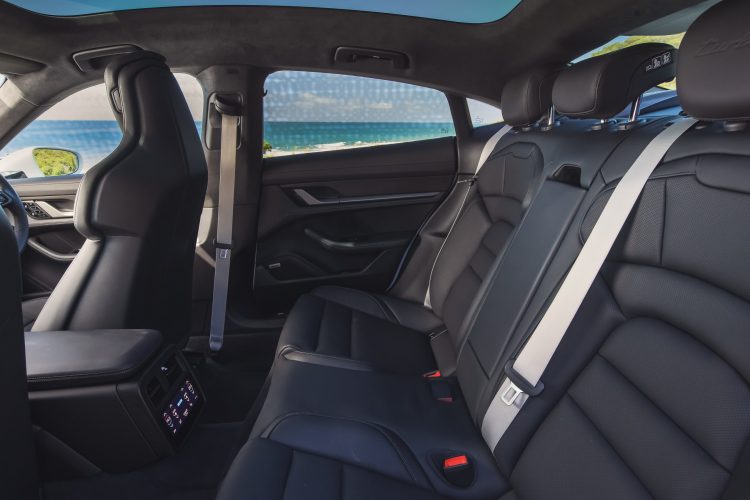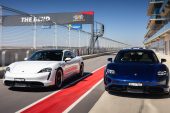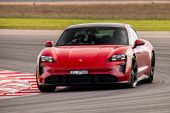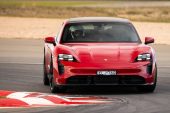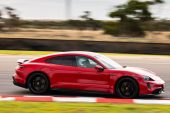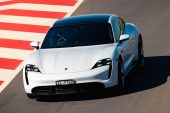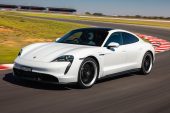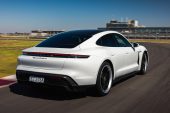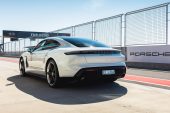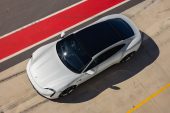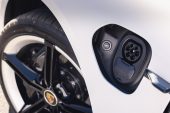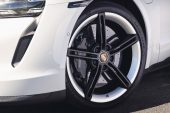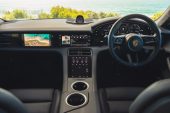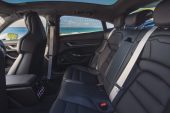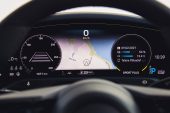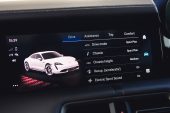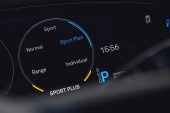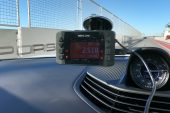Welcome to Porsche’s first series production electric vehicle and the quickest vehicle we’ve ever tested. It’s called the Taycan, and what we’re focusing on here are the flagship Turbo and Turbo S variants.
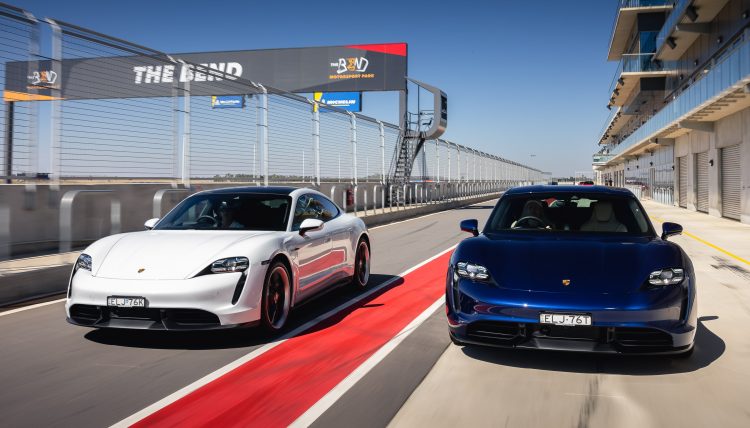
There is no turbocharger, despite what the badge might suggest. The name is simply following tradition and reflecting the fact it is a top-shelf Porsche model. However, they definitely provide ‘turbo’-like performance. In fact, the Turbo S is literally the most powerful Porsche currently on the market – that ought to be enough credibility for the iconic italic turbo motif?
Even with their awe-inspiring performance these two are not the most expensive models in the company’s showroom. Prices start from a mere $268,500 for the Turbo and from $338,500 for the Turbo S. That’s quite a bit less than the 911 Turbo (from $396,400) and 911 Turbo S (from $473,500), for example. In other words, the so-called bang-for-your-buck, albeit silent, is good.
2021 Porsche Taycan Turbo – THE SPECS
Motor: Two AC synchronous
Battery: 93.4kWh (Performance Plus)
Output: 500kW / 850Nm (overboost)
Transmission: Single-speed front, two-speed rear axle
Drive type: All-wheel drive
Official range: 420km
Unladen weight: 2305kg
0-100km/h (tested): 3.177 seconds
0-200km/h (claimed): 10.6 seconds
1/4 mile (claimed): 11.1 seconds
Priced from: $268,500
2021 Porsche Taycan Turbo S – THE SPECS
Motor: Two AC synchronous
Battery: 93.4kWh (Performance Plus)
Output: 560kW / 1050Nm (overboost)
Transmission: Single-speed front, two-speed rear axle
Drive type: All-wheel drive
Official range: 405km
Unladen weight: 2295kg
0-100km/h (tested): 2.518 seconds
0-200km/h (claimed): 9.6 seconds
1/4 mile (claimed): 10.7 seconds
Priced from: $338,500
2021 Porsche Taycan Turbo & Turbo S – THE PACKAGE
This is obviously a brand new vehicle for Porsche, and a new direction for the brand in terms of powertrain technology. It’s based on a fresh platform, called the J1, which is also shared with the new Audi e-tron GT. Porsche offers the Taycan in four-door sedan/coupe body style, or a slightly raised-up crossover format called the Taycan Cross Turismo.
Although it looks like nothing else in the showroom, the design is inspired by some of Porsche’s legendary models. The flat and low front end and bulbous wheel arches, for example, have a whiff of 911 about them, as do the drawn-in C-pillars. The full-width taillight at the back is also representative of the brand’s latest trend. However, it’s all inspired by the stunning Mission E concept car that Porsche unveiled in 2015.
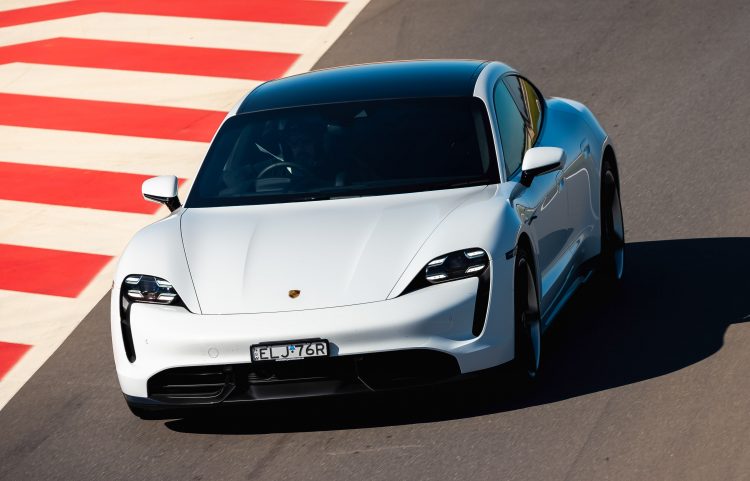
We love that Porsche hasn’t ventured too far away from that initial concept design. Even the white-wall 21-inch alloy wheels on the Turbo S look remarkably familiar. The car definitely stands out on the road, especially for a four-door sedan. And with batteries mounted under the floor and only an electric motor at the front and rear axle, the Taycan showcases a very low profile. So it looks suitably sporty.
Aerodynamics play an extremely important role in performance cars, and perhaps even more so with electric vehicles. As such, the Taycan has been designed to be as slippery through the air as possible. So, the underbody is completely flat and covered with specially-shaped panels to maximise airflow. There’s also active flaps in the front end that open and close for optimum performance and efficiency, and even the standard air suspension automatically lowers the body 10mm above 90km/h, and then 22mm above 180km/h to improve aero and stability.
As a result, the Taycan is one of the most aerodynamic vehicles on the market. The Turbo variant offers a drag coefficient value of just 0.22. That’s lower than the current Toyota Prius (0.24), and that has to put up with looking like it has a sucking vacuum cleaner stuck on the front end of it.
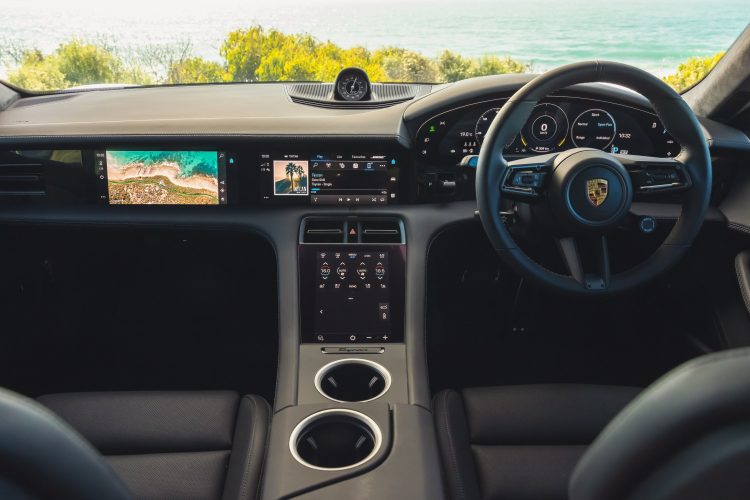
Open the door and you’re greeted by a modern but typical Porsche decor and layout. It blends in some traditional elements, such as a straight and flat dashboard on the passenger side, while the instrument cluster is fully digital. There’s also a pair of touch-screens on the main fascia; one for infotainment and a lower screen for some vehicle and climate settings.
The screens display very sharp graphics and the touch response is excellent. As we’ve commented before on Porsche’s latest interfaces, the layout and menus can seem a bit colourless and sterile. But you can configure widgets yourself to create an ideal home screen for a personal and very practical touch.
Rear passengers are treated to their own climate controls as standard with the Turbo and Turbo S (four-zone climate control), and there’s a reasonable amount of legroom and headroom for a swoopy, four-door coupe-style of car. Coincidentally, this media event also hosted the launch of the new Panamera (review of that coming soon). After jumping out of that we think there is a bit more space in the back of the Panamera in comparison. The chunky seats fitted to these Taycan test vehicles probably soak up a bit of room as well, or at least the perception of room.
Being fully electric, there are two boot areas. The rear section is quite shallow but offers a decent volume, at 366L, and then under the bonnet at the front you have an additional space rated at 84L. This front area is ideal for storing smaller items that you don’t want sliding about. And if you combine the two compartments you’re left with 450L, which is about the same as a mid-size premium sedan (Audi A4, BMW 3 Series etc).
2021 Porsche Taycan Turbo & Turbo S – THE TRACK
Both feature a 93.4kWh battery, mounted under the floor for optimum weight distribution (49:51, front:rear) and low centre of gravity, feeding two AC synchronous electric motors. The front uses a single-speed transmission while the rear features a two-speed transmission. We don’t understand how that works but you can feel it on the road. When second gear comes in it’s like an after-burner, propelling you forward with extraordinary force. During overboost the Turbo unleashes up to 500kW and 850Nm, while the S creates a colossal 560kW and 1050Nm. Yep, mega.
During this event we only had a chance to drive the new model on the track. Specifically, The Bend Motorsport Park in South Australia. Electric vehicles are not ordinarily designed for track driving. Not as a primary focus anyway. However, Porsche wants everyone to know the Taycan has been developed, above all else, as a true Porsche. It is ready for all of the usual demands that any other Porsche is designed to meet. And in that sense, the Taycan is easily the best-prepared electric vehicle on the Australian market for track driving.
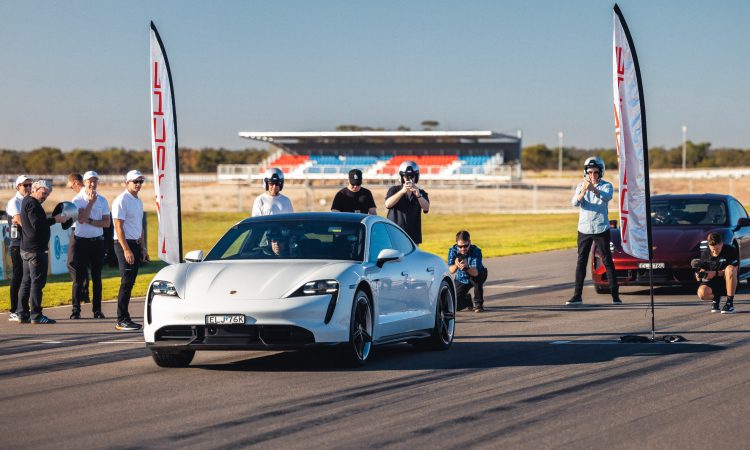
First, we were all given a chance to test out the acceleration of both variants on the main straight of the circuit. Unlike some electric vehicles, which become slower and slower as the battery is depleted, Porsche claims the clever powertrain in the Taycan maintains its performance throughout. And, according to the Qstarz GPS data logger that was clipped to these test cars, the performance does indeed remain very consistent, even after enduring 30 runs or more.
Our best 0-100km/h time in the Turbo was 3.177 seconds, according to the Qstarz device. The best we achieved in the S was 2.518 seconds, although, some journalists were hitting high 2.4s. This proves the car is very consistent even as the battery level drops. In fact, our first run in the S scored a time of 2.609, and then the second run, in the same car, it achieved the sprint in 2.518 seconds.
As for the times themselves, we don’t know if the Qstarz timer had a one-foot rollout function activated. Some timing equipment subtracts the first foot to replicate drag strip conditions (we never include it in our usual tests with our Vbox). Either way, Porsche claims the sprints can be done in 3.2 seconds and 2.8 seconds, respectively. It is insanely quick.
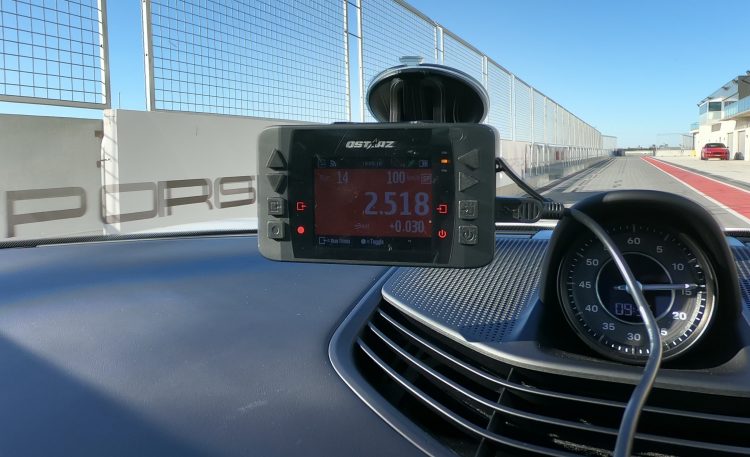
One of the main challenges for EVs out on the circuit is weight. Battery packs and electric motors weigh a lot. Often much more than a typical combustion engine and transmission. And it’s a similar story with the Taycan. According to the specs the Turbo has an unladen weight of 2305kg while the Turbo S weighs 2295kg. Both of these figures are very high compared with an equivalent performance sedan with a petrol engine. For example, the latest Panamera Turbo S, which is also an all-wheel drive four-door sedan, has a tare weight of 2022kg. That’s well over 250kg difference.
Around the longer sweeping bends of this circuit we did notice some additional tyre scrub compared with the new 911 Turbo, which we also sampled as part of this event. In fairness though, the 911 Turbo is a different animal and not a key target for the Taycan – it’s a coupe, for starters. But in our opinion you do have to prepare your mind differently to driving a petrol car. It’s like there is a finer art to be learnt in regards to driving an electric Porsche on the track.
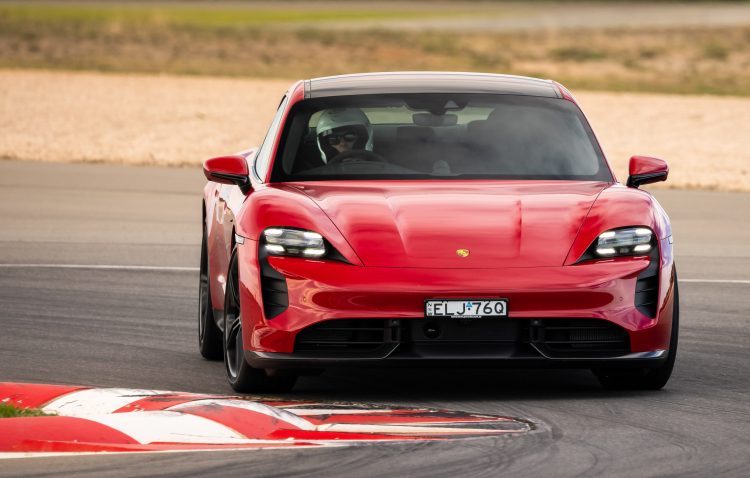
In a combustion-engine Porsche, with a higher centre of gravity, you can throw the weight around to manipulate the balance of the car to your desire. In the Taycan, it can feel less dynamic and a bit monotone in comparison. Again though, we have limited experience with driving electric vehicles at pace on a circuit. And we certainly have zero experience chasing down a new 911 Turbo S lead car in an electric Porsche. This was a completely new and surreal experience for us (yep, and a lot of fun – see video below).
Despite all of this, and without meaning to turn this into a comparison, there are other elements that help the Taycan stand out even among its showroom peers. Although the new 911 Turbo’s engine is seriously responsive, it does require the ideal gear. Whereas in the Taycan, it doesn’t matter. You get instantaneous acceleration the moment you move the pedal, and to what degree is exactly in correspondence to how much you move the pedal. And that really helps compensate for that extra weight. It’s also a unique source of fun and excitement that no road-going petrol Porsche can match.
In the tighter corners the Taycan really catapults from the apex thanks to that amazing response. You can also feel the rear end squirming under full power, particularly when the rear axle is still in its first gear. In these slower scenarios we feel like the Taycan is more like a typical Porsche. The superb steering provides excellent feedback, and the more lock you dial in the more entertaining it is. We get the feeling this would be a wonderful sports car to drive along a nice winding road.
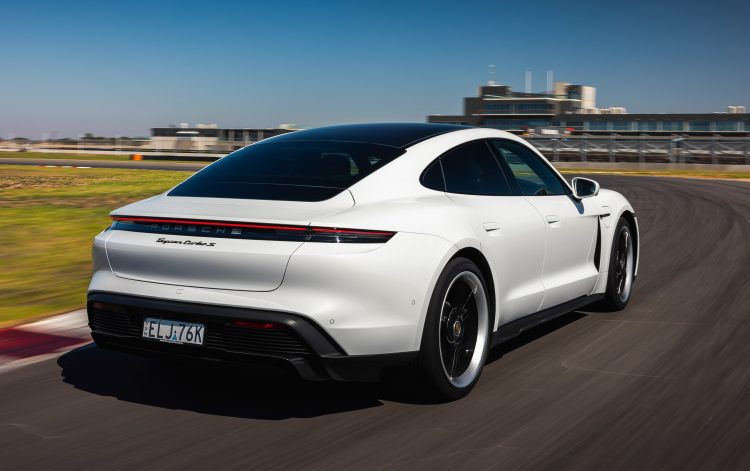
Switching to the Taycan Turbo S, we don’t immediately notice the additional 60kW and 200Nm. Roll-on acceleration, from 40km/h and beyond, feels quite similar to be honest. In that, it’s proper, neck-snapping stuff. But in the top end you can feel the S pulling stronger; the non-S starts to plateau somewhat at around 180-200km/h. In both cases, the top speed is 260km/h, so on the main straight, against the 911 Turbo, the Taycan does eventually taper off.
Porsche is renowned for its insane brakes and so as no surprise the Taycan is well equipped in this department, too. As standard the Turbo comes with 410mm front and 365mm rear steel discs with six-piston calipers on the front. Going for the top Turbo S gets you eye-popping ceramic composite discs, with massive 10-piston calipers on the front. These are optional on the Turbo as well ($12,520). These provide brutal stopping g-force.
Flogging up to the 911 Turbo lead car we had more confidence in the S with these brakes compared with the non-S. Not that the regular setup is weak. It’s just that the ceramic items feel more consistent in pedal feel, and resist fade pretty much at a constant and relentless level. Whereas the steel brakes can change their feel under extreme heat.
2021 Porsche Taycan Turbo & Turbo S – THE VIDEO
2021 Porsche Taycan Turbo & Turbo S – THE VERDICT
So, what’s it like driving an electric Porsche on a track? Is it just as fun as driving a combustion-engine Porsche? One of the main differences we dislike is the fact you can’t come belting up to a corner, jump on the brakes, and downshift through the gears. This operation, to us, really makes you feel engaged and integral with the whole process. Even if it’s slower to change gears or whatever, there is something real and stimulating about cracking down gears. So in that sense it is something you may have to sacrifice, if you feel the same way about this.
Also, there’s no engine sound. Obviously. Well, there is a switchable sound mode that makes the Taycan emit a rather cool UFO-like hum. But it’s nothing like the revving scream of a petrol motor. In our opinion, engine sound is one of the fundamental elements that make up a thoroughly enjoyable drive. And you just don’t get that with an EV. Even a Porsche EV. Again, it doesn’t stimulate the senses quite like a petrol engine. In this regard anyway.
In saying all of that though, we can definitely see there is a new style of driving that can be explored and appreciated with a high-performance electric Porsche. For example, the immediate response from the motors mean you have finer control of power delivery; it’s at a level never before seen in a petrol car. On the track, it means you can make even more precise inputs. And that on its own is a new dimension of engagement and stimulation. The sheer power and torque is also incredibly stimulating, and it can easily keep up with very serious super sports cars and even supercars. In fact, the acceleration offered here will genuinely alter your perceptions of what you thought was humanly possible.
Above all, the steering and the way the Taycan feels on the tarmac is pure Porsche. You feel connected to the chassis and you always know what the tyres are doing and how the car is reacting to your inputs. And that’s the most important thing. It is a real Porsche. It just happens to be electric. We have a feeling the on-road drive experience will be even more surreal than on the track. Especially up a nice mountain pass or along a flowing coastal ribbon.
